Analysis of Funding Sources and Investment Appraisal for Zylla Ltd.
VerifiedAdded on 2020/10/05
|9
|1602
|109
Report
AI Summary
This report analyzes the financial strategies of Zylla Ltd., a company providing services for crossing people, goods, and vehicles. It explores both short-term and long-term funding sources, including equity shares, loans, bank overdrafts, discounted bills, and commercial paper, considering their suitability for acquiring a ferry and meeting working capital requirements. The report evaluates investment appraisal techniques such as Net Present Value (NPV), Internal Rate of Return (IRR), and Payback Period to assess the viability of the ferry acquisition project. The NPV calculation reveals a positive value, indicating the project's profitability. The IRR of 38.16% exceeds the company's cost of capital, further supporting the investment. The payback period of 2.3 years suggests a relatively quick return on investment. The report concludes with recommendations, emphasizing the accuracy of the NPV method and suggesting Zylla Ltd. proceed with the investment based on the positive financial indicators. The report references several financial management books and journals.

REPORT
Paraphrase This Document
Need a fresh take? Get an instant paraphrase of this document with our AI Paraphraser
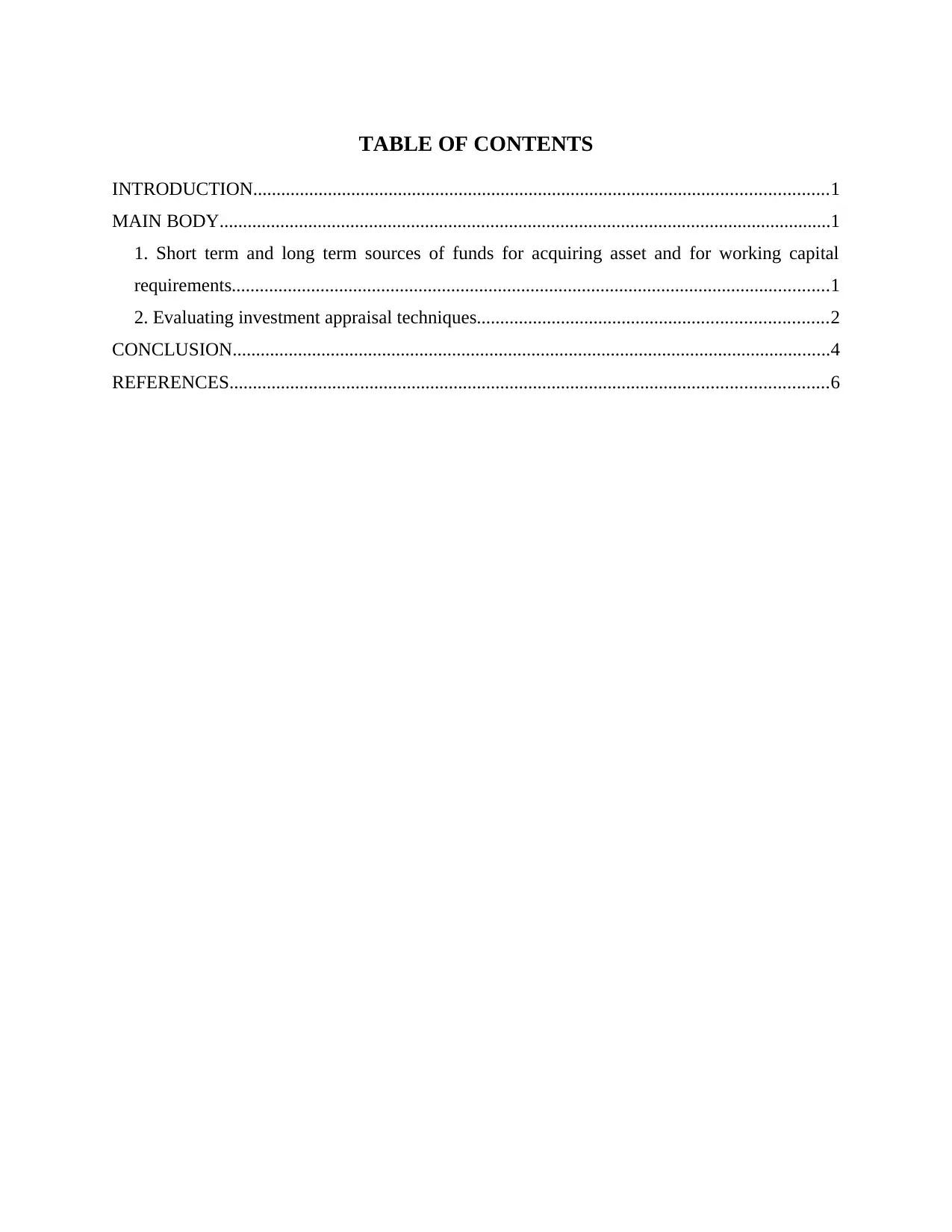
TABLE OF CONTENTS
INTRODUCTION...........................................................................................................................1
MAIN BODY...................................................................................................................................1
1. Short term and long term sources of funds for acquiring asset and for working capital
requirements................................................................................................................................1
2. Evaluating investment appraisal techniques...........................................................................2
CONCLUSION................................................................................................................................4
REFERENCES................................................................................................................................6
INTRODUCTION...........................................................................................................................1
MAIN BODY...................................................................................................................................1
1. Short term and long term sources of funds for acquiring asset and for working capital
requirements................................................................................................................................1
2. Evaluating investment appraisal techniques...........................................................................2
CONCLUSION................................................................................................................................4
REFERENCES................................................................................................................................6
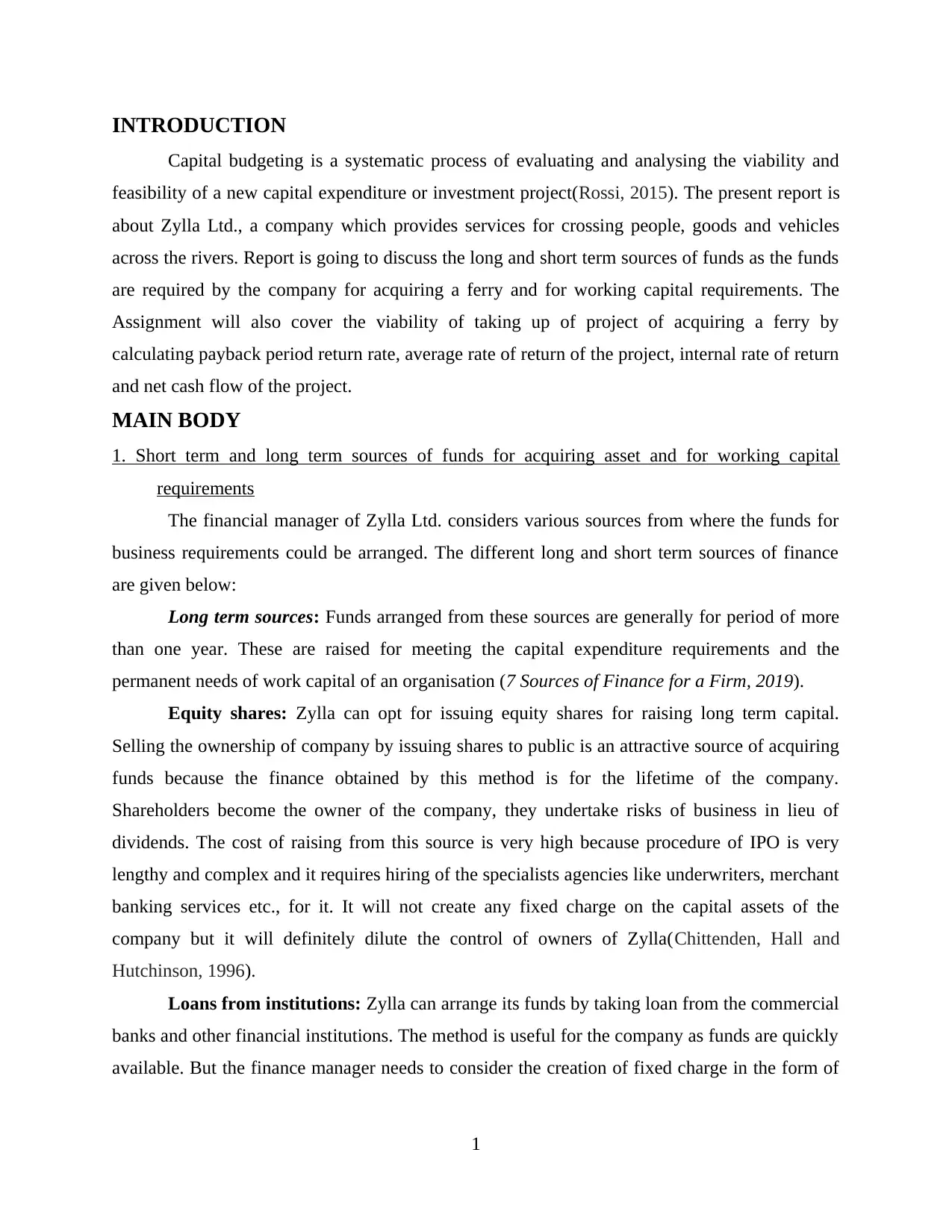
INTRODUCTION
Capital budgeting is a systematic process of evaluating and analysing the viability and
feasibility of a new capital expenditure or investment project(Rossi, 2015). The present report is
about Zylla Ltd., a company which provides services for crossing people, goods and vehicles
across the rivers. Report is going to discuss the long and short term sources of funds as the funds
are required by the company for acquiring a ferry and for working capital requirements. The
Assignment will also cover the viability of taking up of project of acquiring a ferry by
calculating payback period return rate, average rate of return of the project, internal rate of return
and net cash flow of the project.
MAIN BODY
1. Short term and long term sources of funds for acquiring asset and for working capital
requirements
The financial manager of Zylla Ltd. considers various sources from where the funds for
business requirements could be arranged. The different long and short term sources of finance
are given below:
Long term sources: Funds arranged from these sources are generally for period of more
than one year. These are raised for meeting the capital expenditure requirements and the
permanent needs of work capital of an organisation (7 Sources of Finance for a Firm, 2019).
Equity shares: Zylla can opt for issuing equity shares for raising long term capital.
Selling the ownership of company by issuing shares to public is an attractive source of acquiring
funds because the finance obtained by this method is for the lifetime of the company.
Shareholders become the owner of the company, they undertake risks of business in lieu of
dividends. The cost of raising from this source is very high because procedure of IPO is very
lengthy and complex and it requires hiring of the specialists agencies like underwriters, merchant
banking services etc., for it. It will not create any fixed charge on the capital assets of the
company but it will definitely dilute the control of owners of Zylla(Chittenden, Hall and
Hutchinson, 1996).
Loans from institutions: Zylla can arrange its funds by taking loan from the commercial
banks and other financial institutions. The method is useful for the company as funds are quickly
available. But the finance manager needs to consider the creation of fixed charge in the form of
1
Capital budgeting is a systematic process of evaluating and analysing the viability and
feasibility of a new capital expenditure or investment project(Rossi, 2015). The present report is
about Zylla Ltd., a company which provides services for crossing people, goods and vehicles
across the rivers. Report is going to discuss the long and short term sources of funds as the funds
are required by the company for acquiring a ferry and for working capital requirements. The
Assignment will also cover the viability of taking up of project of acquiring a ferry by
calculating payback period return rate, average rate of return of the project, internal rate of return
and net cash flow of the project.
MAIN BODY
1. Short term and long term sources of funds for acquiring asset and for working capital
requirements
The financial manager of Zylla Ltd. considers various sources from where the funds for
business requirements could be arranged. The different long and short term sources of finance
are given below:
Long term sources: Funds arranged from these sources are generally for period of more
than one year. These are raised for meeting the capital expenditure requirements and the
permanent needs of work capital of an organisation (7 Sources of Finance for a Firm, 2019).
Equity shares: Zylla can opt for issuing equity shares for raising long term capital.
Selling the ownership of company by issuing shares to public is an attractive source of acquiring
funds because the finance obtained by this method is for the lifetime of the company.
Shareholders become the owner of the company, they undertake risks of business in lieu of
dividends. The cost of raising from this source is very high because procedure of IPO is very
lengthy and complex and it requires hiring of the specialists agencies like underwriters, merchant
banking services etc., for it. It will not create any fixed charge on the capital assets of the
company but it will definitely dilute the control of owners of Zylla(Chittenden, Hall and
Hutchinson, 1996).
Loans from institutions: Zylla can arrange its funds by taking loan from the commercial
banks and other financial institutions. The method is useful for the company as funds are quickly
available. But the finance manager needs to consider the creation of fixed charge in the form of
1
⊘ This is a preview!⊘
Do you want full access?
Subscribe today to unlock all pages.

Trusted by 1+ million students worldwide
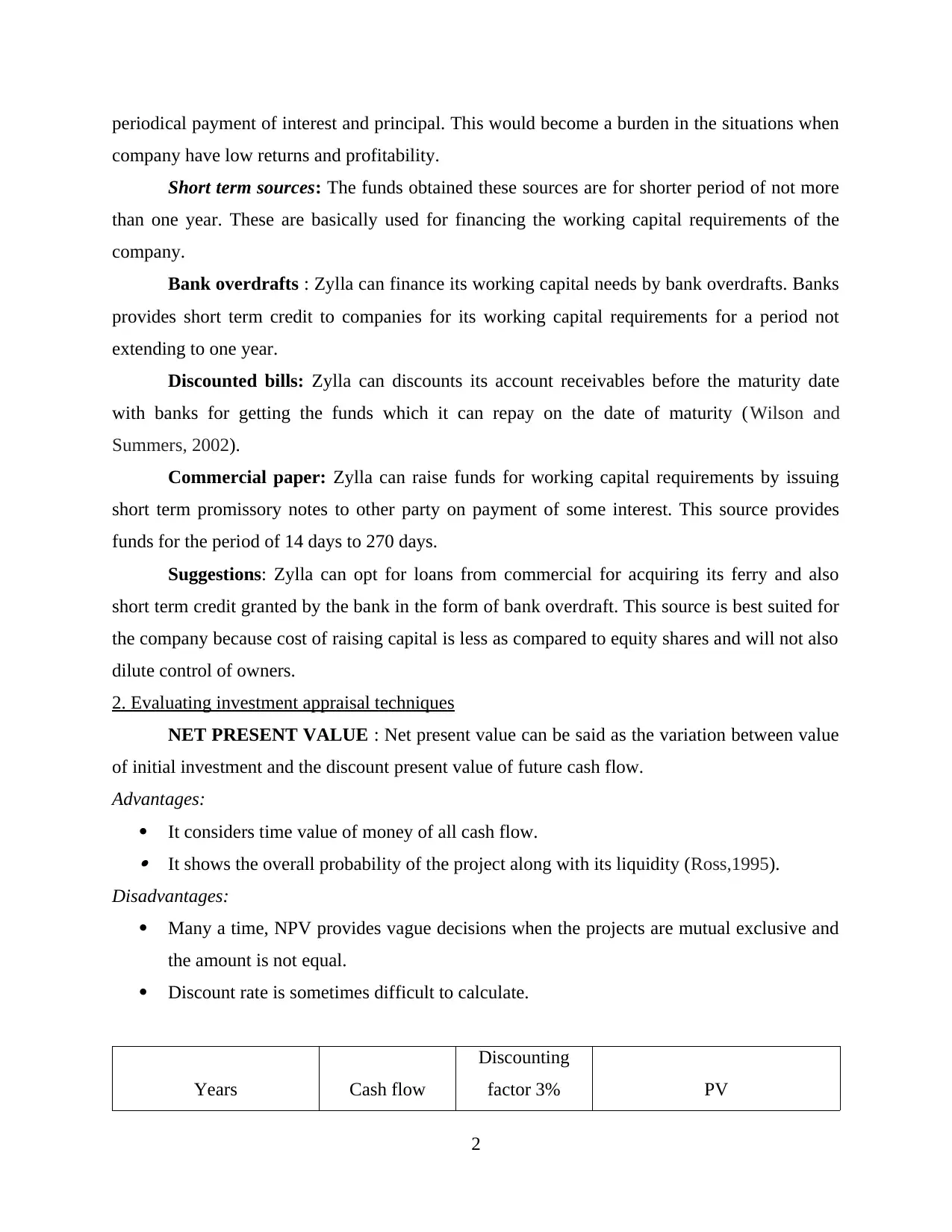
periodical payment of interest and principal. This would become a burden in the situations when
company have low returns and profitability.
Short term sources: The funds obtained these sources are for shorter period of not more
than one year. These are basically used for financing the working capital requirements of the
company.
Bank overdrafts : Zylla can finance its working capital needs by bank overdrafts. Banks
provides short term credit to companies for its working capital requirements for a period not
extending to one year.
Discounted bills: Zylla can discounts its account receivables before the maturity date
with banks for getting the funds which it can repay on the date of maturity (Wilson and
Summers, 2002).
Commercial paper: Zylla can raise funds for working capital requirements by issuing
short term promissory notes to other party on payment of some interest. This source provides
funds for the period of 14 days to 270 days.
Suggestions: Zylla can opt for loans from commercial for acquiring its ferry and also
short term credit granted by the bank in the form of bank overdraft. This source is best suited for
the company because cost of raising capital is less as compared to equity shares and will not also
dilute control of owners.
2. Evaluating investment appraisal techniques
NET PRESENT VALUE : Net present value can be said as the variation between value
of initial investment and the discount present value of future cash flow.
Advantages:
It considers time value of money of all cash flow. It shows the overall probability of the project along with its liquidity (Ross,1995).
Disadvantages:
Many a time, NPV provides vague decisions when the projects are mutual exclusive and
the amount is not equal.
Discount rate is sometimes difficult to calculate.
Years Cash flow
Discounting
factor 3% PV
2
company have low returns and profitability.
Short term sources: The funds obtained these sources are for shorter period of not more
than one year. These are basically used for financing the working capital requirements of the
company.
Bank overdrafts : Zylla can finance its working capital needs by bank overdrafts. Banks
provides short term credit to companies for its working capital requirements for a period not
extending to one year.
Discounted bills: Zylla can discounts its account receivables before the maturity date
with banks for getting the funds which it can repay on the date of maturity (Wilson and
Summers, 2002).
Commercial paper: Zylla can raise funds for working capital requirements by issuing
short term promissory notes to other party on payment of some interest. This source provides
funds for the period of 14 days to 270 days.
Suggestions: Zylla can opt for loans from commercial for acquiring its ferry and also
short term credit granted by the bank in the form of bank overdraft. This source is best suited for
the company because cost of raising capital is less as compared to equity shares and will not also
dilute control of owners.
2. Evaluating investment appraisal techniques
NET PRESENT VALUE : Net present value can be said as the variation between value
of initial investment and the discount present value of future cash flow.
Advantages:
It considers time value of money of all cash flow. It shows the overall probability of the project along with its liquidity (Ross,1995).
Disadvantages:
Many a time, NPV provides vague decisions when the projects are mutual exclusive and
the amount is not equal.
Discount rate is sometimes difficult to calculate.
Years Cash flow
Discounting
factor 3% PV
2
Paraphrase This Document
Need a fresh take? Get an instant paraphrase of this document with our AI Paraphraser
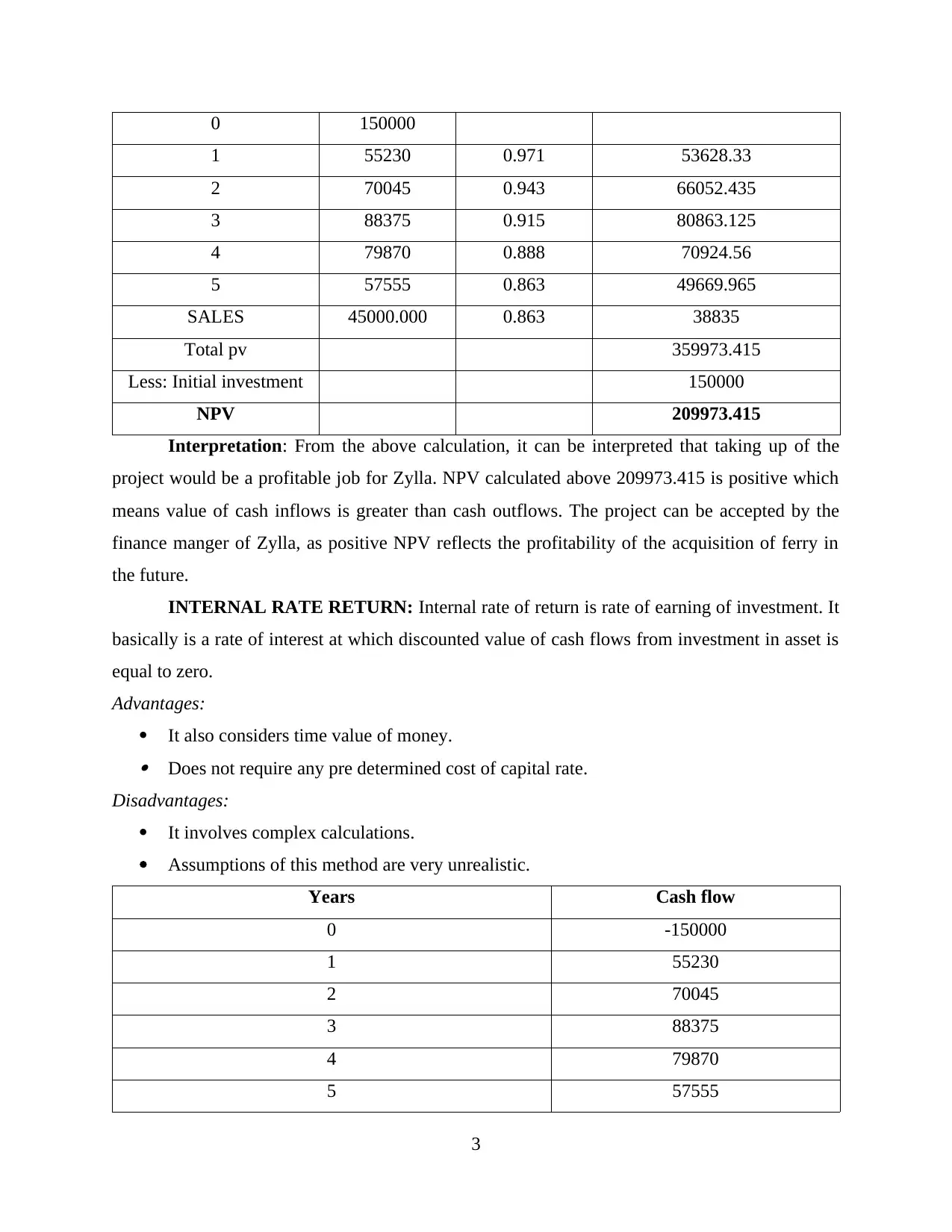
0 150000
1 55230 0.971 53628.33
2 70045 0.943 66052.435
3 88375 0.915 80863.125
4 79870 0.888 70924.56
5 57555 0.863 49669.965
SALES 45000.000 0.863 38835
Total pv 359973.415
Less: Initial investment 150000
NPV 209973.415
Interpretation: From the above calculation, it can be interpreted that taking up of the
project would be a profitable job for Zylla. NPV calculated above 209973.415 is positive which
means value of cash inflows is greater than cash outflows. The project can be accepted by the
finance manger of Zylla, as positive NPV reflects the profitability of the acquisition of ferry in
the future.
INTERNAL RATE RETURN: Internal rate of return is rate of earning of investment. It
basically is a rate of interest at which discounted value of cash flows from investment in asset is
equal to zero.
Advantages:
It also considers time value of money. Does not require any pre determined cost of capital rate.
Disadvantages:
It involves complex calculations.
Assumptions of this method are very unrealistic.
Years Cash flow
0 -150000
1 55230
2 70045
3 88375
4 79870
5 57555
3
1 55230 0.971 53628.33
2 70045 0.943 66052.435
3 88375 0.915 80863.125
4 79870 0.888 70924.56
5 57555 0.863 49669.965
SALES 45000.000 0.863 38835
Total pv 359973.415
Less: Initial investment 150000
NPV 209973.415
Interpretation: From the above calculation, it can be interpreted that taking up of the
project would be a profitable job for Zylla. NPV calculated above 209973.415 is positive which
means value of cash inflows is greater than cash outflows. The project can be accepted by the
finance manger of Zylla, as positive NPV reflects the profitability of the acquisition of ferry in
the future.
INTERNAL RATE RETURN: Internal rate of return is rate of earning of investment. It
basically is a rate of interest at which discounted value of cash flows from investment in asset is
equal to zero.
Advantages:
It also considers time value of money. Does not require any pre determined cost of capital rate.
Disadvantages:
It involves complex calculations.
Assumptions of this method are very unrealistic.
Years Cash flow
0 -150000
1 55230
2 70045
3 88375
4 79870
5 57555
3
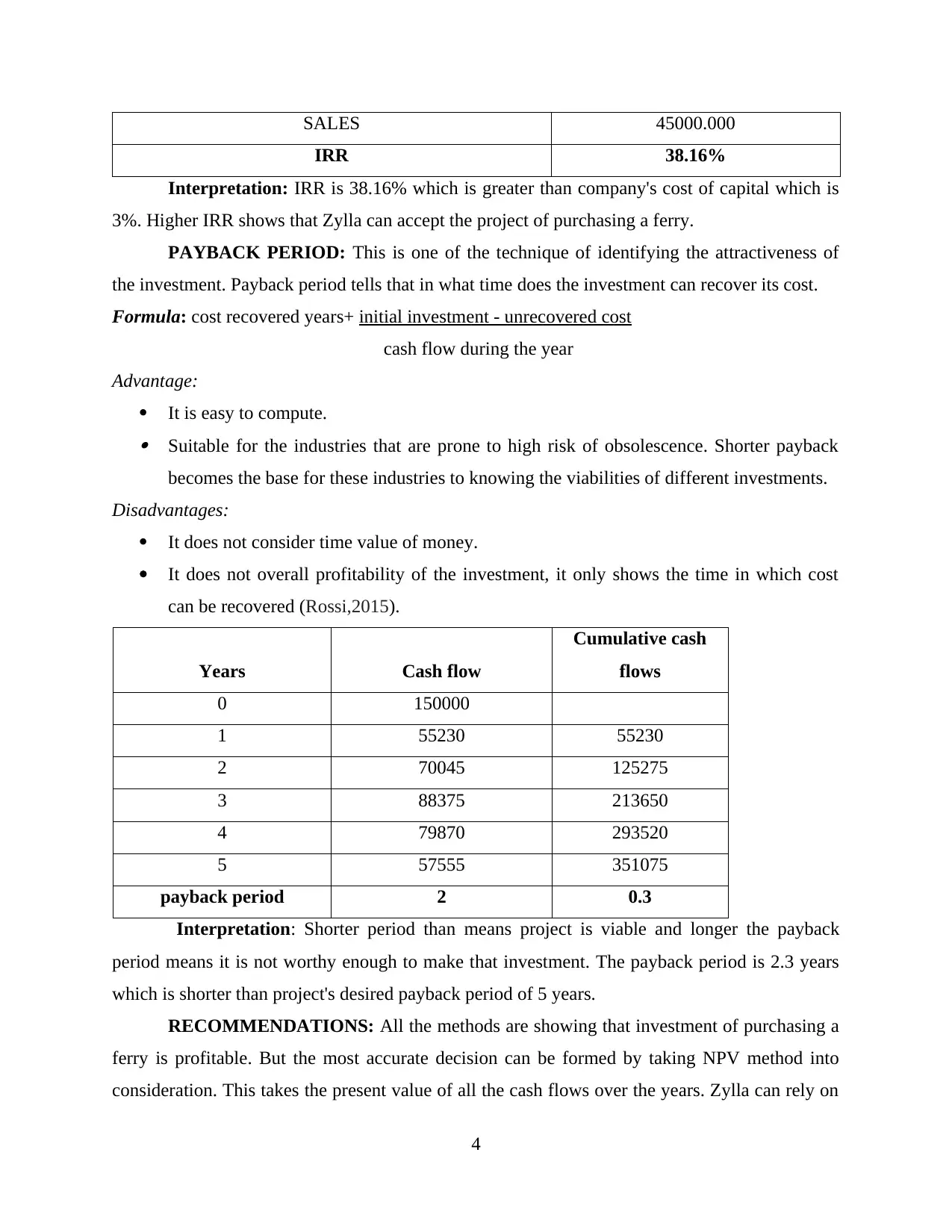
SALES 45000.000
IRR 38.16%
Interpretation: IRR is 38.16% which is greater than company's cost of capital which is
3%. Higher IRR shows that Zylla can accept the project of purchasing a ferry.
PAYBACK PERIOD: This is one of the technique of identifying the attractiveness of
the investment. Payback period tells that in what time does the investment can recover its cost.
Formula: cost recovered years+ initial investment - unrecovered cost
cash flow during the year
Advantage:
It is easy to compute. Suitable for the industries that are prone to high risk of obsolescence. Shorter payback
becomes the base for these industries to knowing the viabilities of different investments.
Disadvantages:
It does not consider time value of money.
It does not overall profitability of the investment, it only shows the time in which cost
can be recovered (Rossi,2015).
Years Cash flow
Cumulative cash
flows
0 150000
1 55230 55230
2 70045 125275
3 88375 213650
4 79870 293520
5 57555 351075
payback period 2 0.3
Interpretation: Shorter period than means project is viable and longer the payback
period means it is not worthy enough to make that investment. The payback period is 2.3 years
which is shorter than project's desired payback period of 5 years.
RECOMMENDATIONS: All the methods are showing that investment of purchasing a
ferry is profitable. But the most accurate decision can be formed by taking NPV method into
consideration. This takes the present value of all the cash flows over the years. Zylla can rely on
4
IRR 38.16%
Interpretation: IRR is 38.16% which is greater than company's cost of capital which is
3%. Higher IRR shows that Zylla can accept the project of purchasing a ferry.
PAYBACK PERIOD: This is one of the technique of identifying the attractiveness of
the investment. Payback period tells that in what time does the investment can recover its cost.
Formula: cost recovered years+ initial investment - unrecovered cost
cash flow during the year
Advantage:
It is easy to compute. Suitable for the industries that are prone to high risk of obsolescence. Shorter payback
becomes the base for these industries to knowing the viabilities of different investments.
Disadvantages:
It does not consider time value of money.
It does not overall profitability of the investment, it only shows the time in which cost
can be recovered (Rossi,2015).
Years Cash flow
Cumulative cash
flows
0 150000
1 55230 55230
2 70045 125275
3 88375 213650
4 79870 293520
5 57555 351075
payback period 2 0.3
Interpretation: Shorter period than means project is viable and longer the payback
period means it is not worthy enough to make that investment. The payback period is 2.3 years
which is shorter than project's desired payback period of 5 years.
RECOMMENDATIONS: All the methods are showing that investment of purchasing a
ferry is profitable. But the most accurate decision can be formed by taking NPV method into
consideration. This takes the present value of all the cash flows over the years. Zylla can rely on
4
⊘ This is a preview!⊘
Do you want full access?
Subscribe today to unlock all pages.

Trusted by 1+ million students worldwide
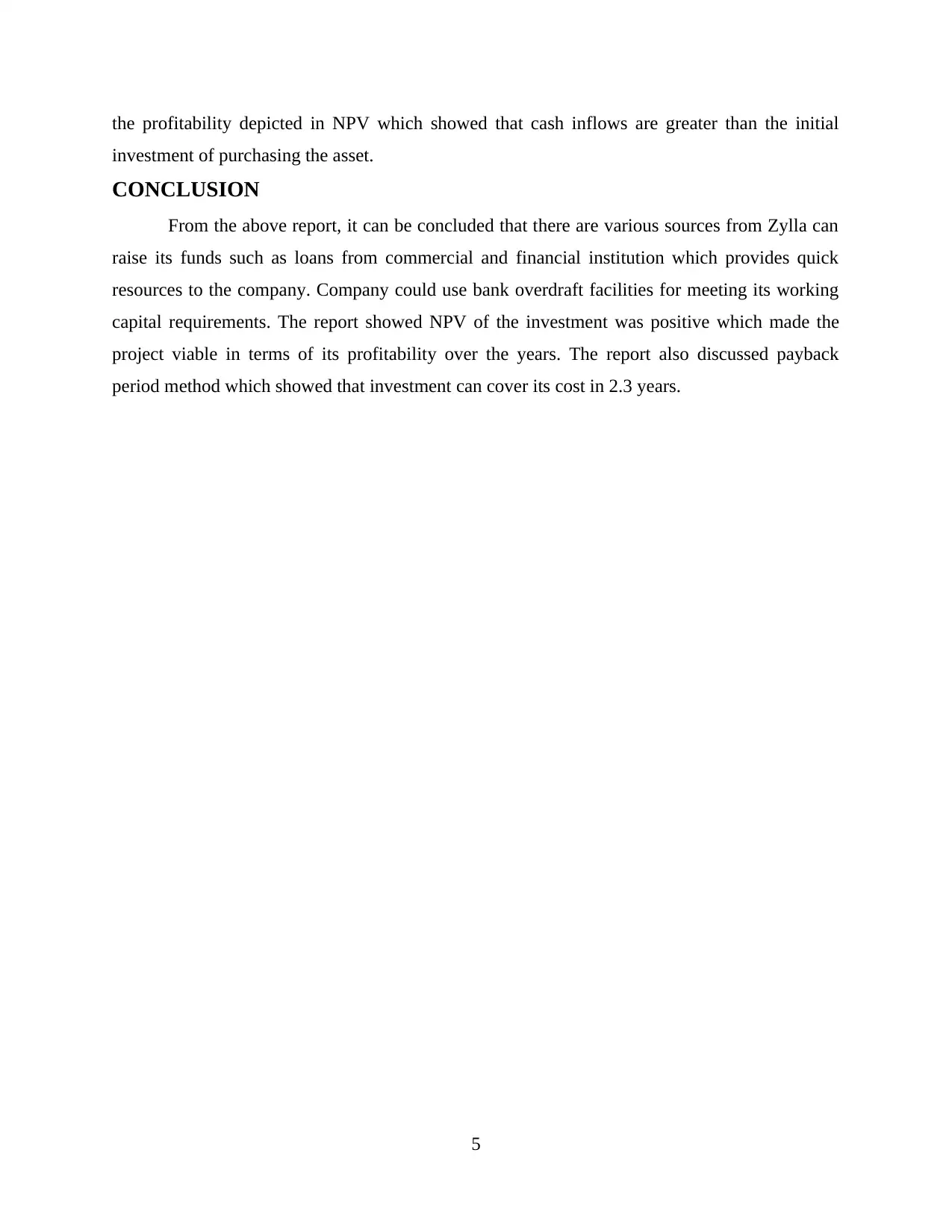
the profitability depicted in NPV which showed that cash inflows are greater than the initial
investment of purchasing the asset.
CONCLUSION
From the above report, it can be concluded that there are various sources from Zylla can
raise its funds such as loans from commercial and financial institution which provides quick
resources to the company. Company could use bank overdraft facilities for meeting its working
capital requirements. The report showed NPV of the investment was positive which made the
project viable in terms of its profitability over the years. The report also discussed payback
period method which showed that investment can cover its cost in 2.3 years.
5
investment of purchasing the asset.
CONCLUSION
From the above report, it can be concluded that there are various sources from Zylla can
raise its funds such as loans from commercial and financial institution which provides quick
resources to the company. Company could use bank overdraft facilities for meeting its working
capital requirements. The report showed NPV of the investment was positive which made the
project viable in terms of its profitability over the years. The report also discussed payback
period method which showed that investment can cover its cost in 2.3 years.
5
Paraphrase This Document
Need a fresh take? Get an instant paraphrase of this document with our AI Paraphraser
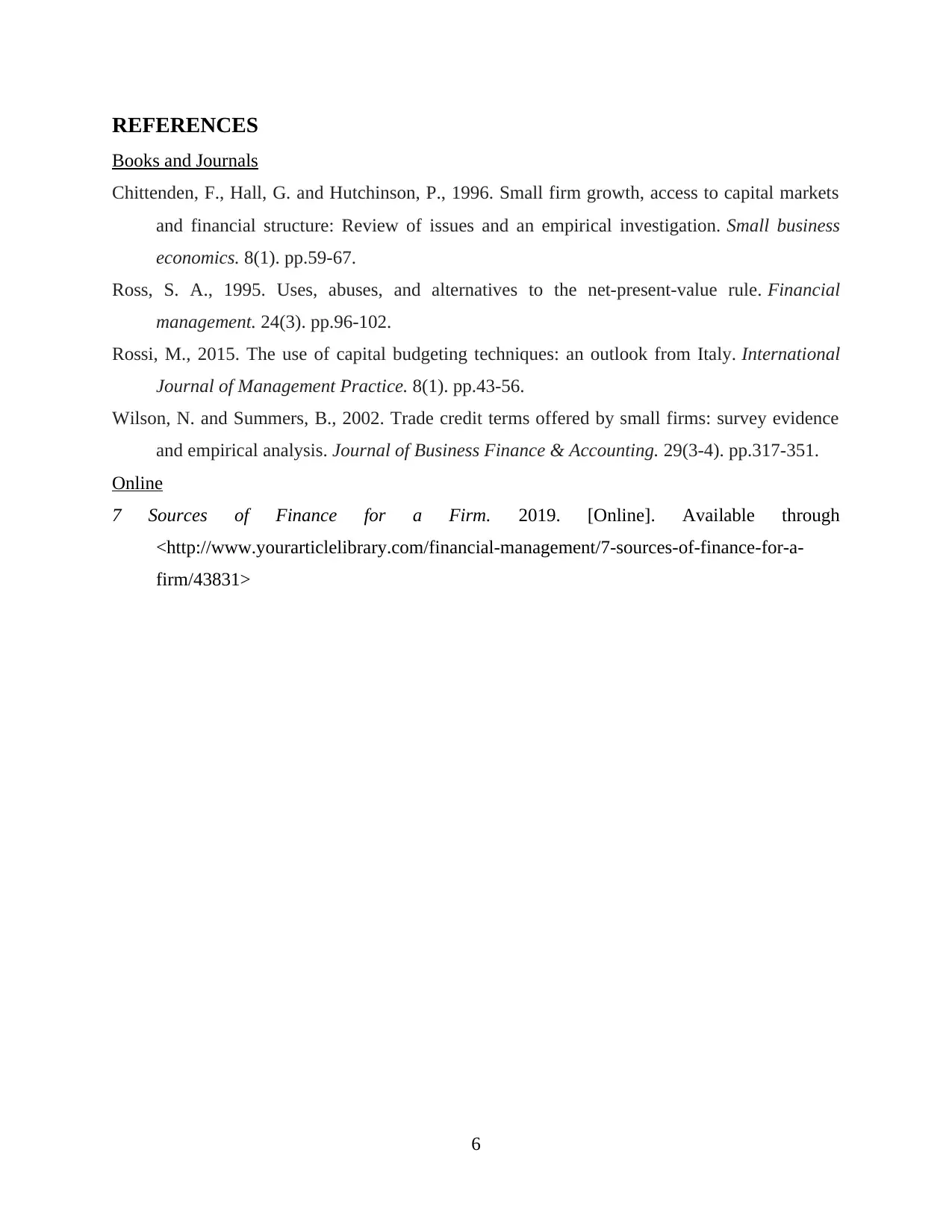
REFERENCES
Books and Journals
Chittenden, F., Hall, G. and Hutchinson, P., 1996. Small firm growth, access to capital markets
and financial structure: Review of issues and an empirical investigation. Small business
economics. 8(1). pp.59-67.
Ross, S. A., 1995. Uses, abuses, and alternatives to the net-present-value rule. Financial
management. 24(3). pp.96-102.
Rossi, M., 2015. The use of capital budgeting techniques: an outlook from Italy. International
Journal of Management Practice. 8(1). pp.43-56.
Wilson, N. and Summers, B., 2002. Trade credit terms offered by small firms: survey evidence
and empirical analysis. Journal of Business Finance & Accounting. 29(3‐4). pp.317-351.
Online
7 Sources of Finance for a Firm. 2019. [Online]. Available through
<http://www.yourarticlelibrary.com/financial-management/7-sources-of-finance-for-a-
firm/43831>
6
Books and Journals
Chittenden, F., Hall, G. and Hutchinson, P., 1996. Small firm growth, access to capital markets
and financial structure: Review of issues and an empirical investigation. Small business
economics. 8(1). pp.59-67.
Ross, S. A., 1995. Uses, abuses, and alternatives to the net-present-value rule. Financial
management. 24(3). pp.96-102.
Rossi, M., 2015. The use of capital budgeting techniques: an outlook from Italy. International
Journal of Management Practice. 8(1). pp.43-56.
Wilson, N. and Summers, B., 2002. Trade credit terms offered by small firms: survey evidence
and empirical analysis. Journal of Business Finance & Accounting. 29(3‐4). pp.317-351.
Online
7 Sources of Finance for a Firm. 2019. [Online]. Available through
<http://www.yourarticlelibrary.com/financial-management/7-sources-of-finance-for-a-
firm/43831>
6

7
⊘ This is a preview!⊘
Do you want full access?
Subscribe today to unlock all pages.

Trusted by 1+ million students worldwide
1 out of 9
Related Documents
Your All-in-One AI-Powered Toolkit for Academic Success.
+13062052269
info@desklib.com
Available 24*7 on WhatsApp / Email
![[object Object]](/_next/static/media/star-bottom.7253800d.svg)
Unlock your academic potential
Copyright © 2020–2025 A2Z Services. All Rights Reserved. Developed and managed by ZUCOL.





